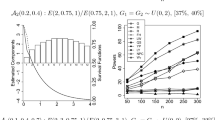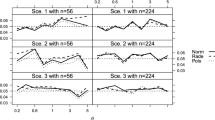Abstract
The current status and panel count data frequently arise from cancer and tumorigenicity studies when events currently occur. A common and widely used class of two sample tests, for current status and panel count data, is the permutation class. We manipulate the double saddlepoint method to calculate the exact mid-p-values of the underlying permutation distributions of this class of tests. Permutation simulations are replaced by analytical saddlepoint computations which provide extremely accurate mid-p-values that are exact for most practical purposes and almost always more accurate than normal approximations. The method is illustrated using two real tumorigenicity panel count data. To compare the saddlepoint approximation with the normal asymptotic approximation, a simulation study is conducted. The speed and accuracy of the saddlepoint method facilitate the calculation of the confidence interval for the treatment effect. The inversion of the mid-p-values to calculate the confidence interval for the mean rate of development of the recurrent event is discussed.
Similar content being viewed by others
References
Abd-Elfattah EF (2009) Testing for independence: saddlepoint approximation to associated permutation distributions. Electron J Stat 3: 625–632
Abd-Elfattah EF, Butler RW (2007) The weighted log-rank class of permutation tests: p-values and confidence intervals using saddlepoint methods. Biometrika 94: 543–551
Abd-Elfattah EF, Butler RW (2009) Log-Rank permutation tests for trend: Saddlepoint p-values and survival rate confidence intervals. Can J Stat 37: 5–16
Agresti A (1992) A survey of exact inference for contingency tables. Stat Sci 7: 131–153
Barlow RE, Bartholomew DJ, Bremner JM, Brunk HD (1972) Statistical inference under order restrictions. John Wiley, New York
Booth JG, Butler RW (1990) Randomization distributions and saddlepoint approximations in generalized linear models. Biometrika 77: 787–796
Butler RW (2007) Saddlepoint approximations with applications. Cambridge University Press, Cambridge
Byar DP (1980) The veterans administration study of chemoprophylaxis for recurrent stage I bladder tumors comparison of placebo, pyridoxine and topical thiotepa. In: Pavone-Maculuso M, Smith PH, Edsmyn F (eds) Bladder tumors and other topics in urological oncology. Plenum, New York, pp 363–370
Daniels HE (1954) Saddlepoint approximation in statistics. Ann Math Stat 25: 631–650
Davis CS, Wei LJ (1988) Nonparametric methods for analyzing incomplete nondecreasing repeated measurements. Biometrics 44: 1005–1018
Davison AC, Hinkley DV (1988) Saddlepoint approximations in resampling methods. Biometrika 75: 417–431
Davison AC, Wang S (2002) Saddlepoint approximations as smoothers. Biometrika 89: 933–938
Dewanji AD, Kalbfleisch JD (1986) Nonparametric methods for survival/sacrifice experiments. Biometrics 42: 325–341
Diamond ID, McDonald JW (1992) Analysis of current status data. In: Trussell J, Hankinson R, Tilton RI (eds) Demographic applications of event history data analysis. Clarendon Press, Oxford, pp 231–252
Diamond ID, McDonald JW, Shah IH (1986) Proportional hazards models for current status data: application to the study of differentials in age at weaning in Pakistan. Demography 23: 607–620
Dinse GE (1994) A comparison of tumor incidence analyses applicable in single-sacrifice animal experiments. Stat Med 13: 689–708
Dinse GE, Lagakos SW (1983) Regression analysis of tumor prevalence data. Appl Stat 32: 236–248
Finkelstein DM (1986) A proportion hazards model for interval censored failure time data. Biometrics 42: 845–854
Gaver DP, O’Muircheartaigh IG (1987) Robust empirical Bayes analyses of event rates. Technometrics 29: 1–15
Groeneboom P (1991) Nonparametric likelihood estimators for interval censoring and deconvolution. Technical Report, Faculty of Technical Mathematics and Informatics. Delft University of Technology, Delft, The Netherlands
Hoel DG, Walburg HE (1972) Statistical analysis of survival experiments. J Natl Cancer Inst 49: 361–372
Huang J (1996) Efficient estimation for the proportional hazards model with interval censoring. Ann Stat 24: 540–568
Ii Y, Kikuchi R, Matsuoka K (1987) Two-dimensional (time and multiplicity) statistical analysis of multiple tumors. Math Biosci 84: 1–21
Jawell NP, Lann M (1995) Generalization of current status data with applications. Lifetime Data Anal 1: 101–109
Kalbfleisch JD, Lawless JF (1985) The analysis of panel data under a Markov assumption. J Am Stat Assoc 80: 863–871
Kiending N (1991) Age-specific incidence and prevalence: a statistical perspective (with discussion). J R Stat Soc A 154: 371–412
Lagakos SW, Louis TA (1988) Use of tumor lethality to interpret tumorigenicity experiments lacking cause-of-death data. Appl Stat 37: 169–179
Lugannani R, Rice SO (1980) Saddlepoint approximations for the distribution of the sum of independent random variables. Adv Appl Probab 12: 475–490
Peto R, Pike MC, Day NE, Gray RG, Lee PN, Parish S, Peto J, Richards S, Wahrendorf J (1980) Guidelines for simple, sensitive significance tests for carcinogenic effects in long-term animal experiments. In: Long-term screening assays for carcinogens: a critical appraisal. International Agency for Research on Cancer, Lyon, pp 311–426
Robinson J (1982) Saddlepoint approximations for permutation tests and confidence intervals. J R Stat Soc B 44: 91–101
Rossine AJ, Tsiatis A (1996) A semiparametric proportional odds regression model for the analysis of current status data. J Am Stat Assoc 91: 713–721
Routledge RD (1994) Practicing safe statistics with the mid-p. Can J Stat 22: 103–110
Skovgaard IM (1987) Saddlepoint expansions for conditional distributions. J Appl Probab 24: 875–887
Sun J (1999) A nonparametric test for current status data with unequal censoring. J R Stat Soc B 61: 243–250
Sun J (2006) The statistical analysis of interval-censored failure time data. Springer, New York
Sun J, Fang h (2003) A nonparametric test for panel count data. Biometrika 90: 199–208
Sun J, Kalbfleisch JD (1993) The analysis of current status data on point process. J Am Stat Assoc 88: 1449–1454
Sun J, Kalbfleisch JD (1995) Estimation of the mean function of point processes based on panel count data. Stat Sin 5: 279–289
Sun J, Kalbfleisch JD (1996) Nonparametric tests for tumor prevalence data. Biometrics 52: 726–731
Sun J, Wei LJ (2000) Regression analysis of panel count data with covariate-dependent observations and censoring times. J R Stat Soc B 62: 293–302
Thall DF, Lachin JM (1988) An analysis of recurrent events: nonparametric methods for randon-interval count data. J Am Stat Assoc 83: 339–347
Wei LJ, Lin DY, Weissfeld L (1989) Regression analysis of multivariate incomplete failure time data by modeling marginal distributions. J Am Stat Assoc 84: 1065–1073
Wellner JA, Zhang Y (1998) Two estimators of the mean of a counting process with panel count data. Ann Stat 28: 779–814
Author information
Authors and Affiliations
Corresponding author
Rights and permissions
About this article
Cite this article
Abd-Elfattah, E.F. Saddlepoint p-values and confidence intervals for a class of two sample permutation tests for current status and panel count data. Lifetime Data Anal 17, 461–472 (2011). https://doi.org/10.1007/s10985-010-9190-9
Received:
Accepted:
Published:
Issue Date:
DOI: https://doi.org/10.1007/s10985-010-9190-9




